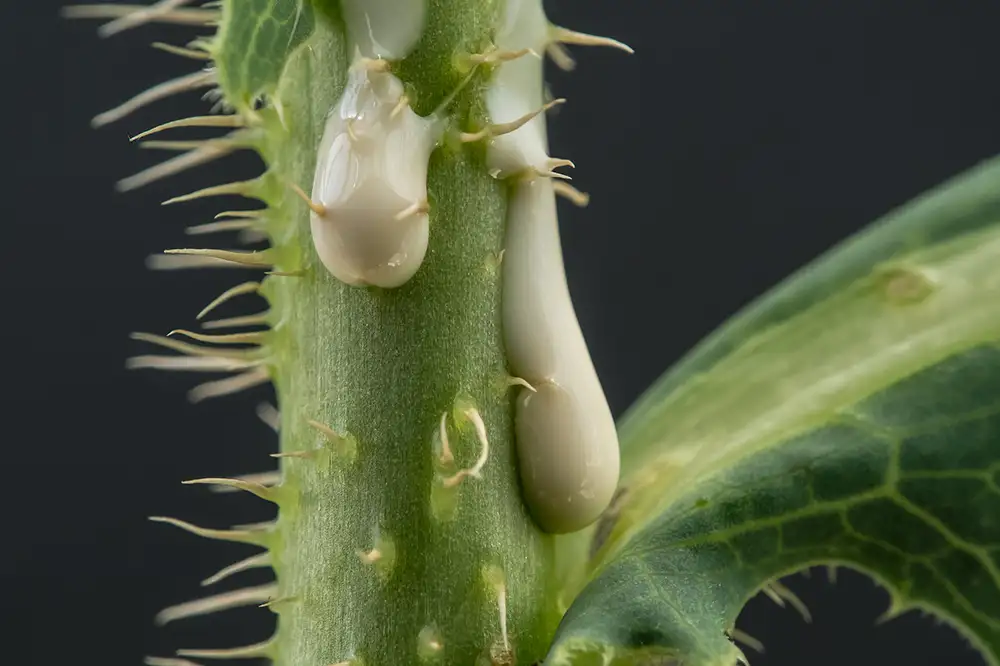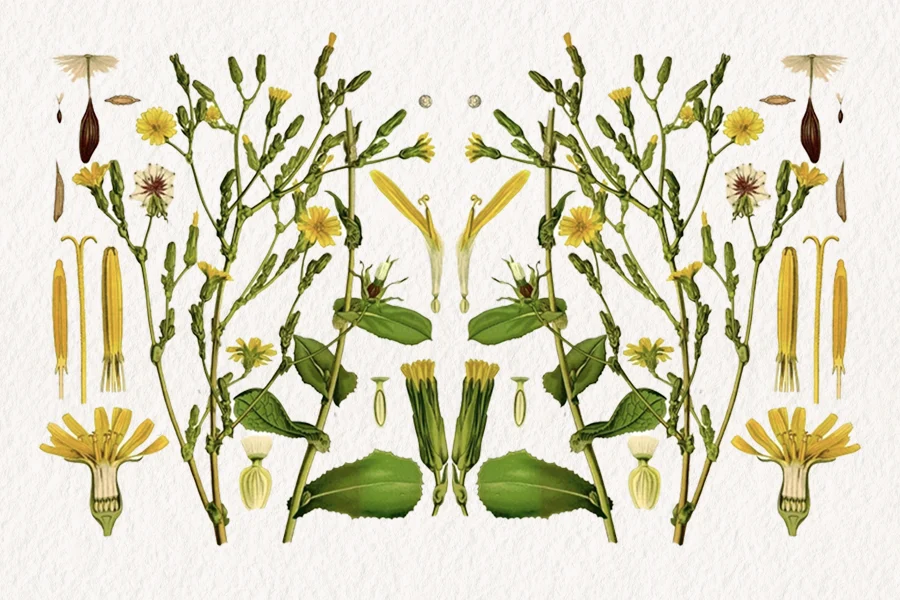When most people think of lettuce, they think of the vegetable that might appear on their salad plates. But some seek out another type of lettuce, known as wild lettuce, for its medicinal properties. Read on to learn more about wild lettuce and how people harvest and consume it for pain relief, relaxation, and more.
Where Does Wild Lettuce Grow?
When people talk about wild lettuce, they are often referring to Lactuca virosa, or bitter lettuce, a weed that originated in Europe and the Middle East but has since been introduced to the US and Australia. It’s sometimes called “opium lettuce” due to its sedative effects, but according to 7Song, director of the Northeast School of Botanical Medicine, it has no relationship with opium. Lactuca virosa is part of the Asteraceae family, a group of plants that includes dandelions and sow thistle, says Caine Barlow, a mycologist who has grown wild lettuce himself in Australia.
READ: Blue Lotus Flower: Smoking, Tea & More

However, other species of wild lettuce exist. 7Song uses Lactuca biennis, or tall blue lettuce, which grows mainly in the US and Canada. Another common type of wild lettuce is Lactuca canadensis, or tall lettuce, which is also native to North America, says 7Song. In the southwest and other parts of the US, it’s common to find the non-native Lactuca serriola, which is distinguishable by the spines that run along the back of its leaves. For more information on where different species of wild lettuce grow, you can check out the USDA Plants Database.
What Does Wild Lettuce Do?
Some people use wild lettuce for its pain-relieving properties.” It’s a mild pain reliever and mildly sedative,” says 7Song, who gives Lactuca biennis to people with chronic back and joint pain. “It’s mild, so I almost always use wild lettuce in combination with other plants.” Others consume wild lettuce for its potential emotional benefits. “I found it had a calming, relaxing effect,” says Barlow.
Lactuca virosa also may have laxative properties and reduce intestinal inflammation. “It is bitter and stimulates digestive juices like bile from the liver and pancreatic enzymes,” says herbalist Christopher Hobbs, PhD. “This stimulates appetite and helps enhance digestion. Wild lettuce is also harvested as an anti-addictive herb and as a relaxing herb to calm the nerves. It is a standard herb for these uses among herbalists but has very little clinical research published.”
READ: How to Make Blue Lotus Tincture

Wild lettuce has been used since the times of ancient Egypt and Rome, Barlow adds. “During the 1800s, it was used by doctors when opium could not be obtained. It was also used as an adulterant for opium. It has been referred to as ‘poor man’s opium.'” Traditional Chinese medicine uses dried wild lettuce juice as an antiseptic, says herbalist Lindsay Etemadipour. People sometimes eat it, too, but it can be “incredibly bitter,” she adds.
How to Grow Shrooms Bundle
Take Both of Our Courses and Save $90!
How to Find Wild Lettuce
7Song harvests Lactuca biennis in Ithaca, NY. ”There are native and non-native wild lettuces, and so I mostly gather the native ones, which are more common around here,” he says. “In other parts of the country, the non-native ones are more common.” Typically, he looks along the roadside or in fields for the lettuce. “You wouldn’t find it deep in the woods.”
Wild lettuce “flourishes in open sunlight, fields, and near-moving water but will not typically grow near wetlands or bogs,” says Etemadipour, who harvests Lactuca virosa in Virginia in the spring and summer.
What Does Wild Lettuce Look Like?
“There are many species of wild lettuce; they can look different,” says 7Song. Lactuca virosa is usually “six to seven feet tall, with stiff, erect stems, the leaves bluish-green and spiny,” according to Barlow. “The basal and lower stem leaves do not have stalks, and they are 3-18 cm long, 2-6 cm wide, oblong to oblanceolate in shape, undivided to deeply lobed. The flowers closely resemble those of dandelions, but the achenes — the capsules containing the seed — are very purple or maroon in color.” Other distinctive features of Lactuca virosa include hairs on the undersides of the leaves and white sap that leaks out when the stems break, says Etemadipour. Lactuca serriola looks similar, so the two species are sometimes confused, Barlow adds.
READ: How To Identify Magic Mushrooms

People looking to forage for wild lettuce will likely need to do extensive research and look at photos of different species. “Anyone interested in foraging should take the time to learn to identify the plant they are seeking,” says Barlow. He recommends researching other plants native to your area that may resemble your target plant. “While we can say dandelion, thistles, and sow thistle are the most likely lookalikes, we cannot rule out similar plants endemic to your area that may be poisonous.” To tell wild lettuce apart from dandelion, keep in mind that wild lettuce has triangular cross-sections, while dandelion roots have oval cross-sections, says Etemadipour.
The Ethics of Foraging Wild Lettuce
Wild lettuce is a perennial plant, meaning that it will come back the next year if you leave the root intact, says 7Song. So, it’s important not to pull out the roots. “I’ll cut it off at the base where the stem meets the ground,” he says, and he will always leave some plants there in case any of the ones he harvests die. He also makes sure that the place he is harvesting from is not private property.

In addition, consider that other people may be foraging in the same place as you. “Only take enough for your needs or for the needs of the people who depend on you,” says Barlow. “You may not be the only person foraging from this location, and it is important to recognize [others’] potential needs as well.” Think of yourself as developing a relationship with the plant, and try to give back to it: “Be gracious. When foraging, accept the gift of the plant and be aware of the responsibility to not over-harvest,” says Barlow. You might even consider helping to spread the plant’s seed or keeping some seeds and learning to grow your own wild lettuce.
How to Harvest and Prepare Wild Lettuce
When 7Song gathers wild lettuce, it goes through a five-day, multi-step process to concentrate the latex, or sap, for its medicinal properties. “The latex is where the medicine is,” he says. First, he cuts the plants and puts them in a blender with ethanol (drinking alcohol), with a 1:2 ratio of 95 percent ethanol to wild lettuce. He lets the blended mixture sit for two days, then uses a tincture press to press out the fluid from the mixture. Then, he gathers more wild lettuce, blends it with ethanol, mixes it with the tincture he’s already made, presses it in the tincture press, and repeats this step again with more wild lettuce. He lets this sit for two weeks, then presses out the last tinctures he’s made.
“The latex (sap) can also be extracted by cutting the tops of the plant and then squeezing the latex repeatedly into a bowl,” says Barlow. Then, you let it dry and dissolve the dried latex in alcohol. Yet another option is to let the leaves sit in hot — not boiling — water for 8-10 hours, discard the leaves, then evaporate the water to produce a black tar. Some people also dry the leaves and roots and make wild lettuce into a tea or even smoke it, Barlow adds. Those who smoke wild lettuce might mix it with cannabis or tobacco.
Safe Consumption of Wild Lettuce
There have been some reports of toxic effects from Lactuca virosa, leading to symptoms like nausea, vomiting, agitation, and even hallucinations, which resolved with medical treatment. 7Song has never personally seen someone have an adverse reaction to his wild lettuce. Still, if you have never consumed it before, start with small amounts to make sure it is safe for you.
“In terms of dosage, around 2.5 to 3 grams of dried plant material — about a teaspoon — or approximately half a gram of tar would be considered a moderate dose,” says Barlow. “A starting dose would probably be a gram of dried plant material (half a teaspoon). And of the dried tar from the plant, probably start with an eighth to a quarter of a gram.” However, he adds, “plants vary in concentration based on where they grow and how healthy they are, so these may vary somewhat. The usual advice is go slow, and work up until you find a dosage that suits you.” And if you’re using any sedatives such as alcohol, opioids, antihistamines like Benadryl, or sedative herbs and supplements, you should avoid wild lettuce altogether.
You can also look out for your safety by being mindful of where you’re harvesting and avoiding places that may be contaminated with sprays and chemicals through industrial use or regular weed control regimes. “The other issue is that plants can take up some heavy metals and toxins from the soil,” Barlow says. “It is not recommended to eat vegetables or herbs grown in locations that may be high in lead or have a history of chemical treatments.”
“The number one thing I always remind others of when foraging is that you must know precisely what you are consuming,” says Etemadipour. “While there are not a ton of poisonous look-alikes to wild lettuce, you still need to be aware of what you are picking.”
Interested in having a psychedelic experience, but don't know where to start? Get our definitive guide on trusted legal retreat centers, clinical trials, therapists, and more.
We started DoubleBlind two years ago at a time when even the largest magazines and media companies were cutting staff and going out of business. At the time we made a commitment: we will never have a paywall, we will never rely on advertisers we don’t believe in to fund our reporting, and we will always be accessible via email and social media to support people for free on their journeys with plant medicines.
To help us do this, if you feel called and can afford it, we ask you to consider becoming a monthly member and supporting our work. In exchange, you'll receive a subscription to our print magazine, monthly calls with leading psychedelic experts, access to our psychedelic community, and much more.



